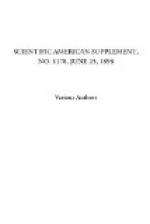Brown or black discoloration of silvered mirrors.—Generally these spots are due to faulty manipulation, too great dilution of the silver solution, or touching the plates with the fingers after they have been cleaned. Sometimes, however, they are due to chemical defects in the glass itself. In these cases, as a general thing, the discolorations occur only after several days—a faultless mirror having been made at first, and the browning subsequently developing slowly. The writer was a student in the laboratory of Baron Liebig during the time that distinguished chemist was carrying out the series of experiments which resulted in devising a method of making silver mirrors commercially. One of the greatest troubles with which he had to contend was this browning—the cause for which was never fully cleared up by him. Some years ago, the writer, having in his possession two mirrors made by Liebig, and which had gradually become brown throughout, undertook an examination of the deposit (which had been thoroughly protected from extraneous influences by a strong film of varnish), and was surprised to find that it consisted of a layer of silver sulphide. Without going into detail, the source of the change was later found to lie within the glass itself. In making glass to be used for mirrors, a considerable portion of sodium sulphate is used, and in annealing, this is partly reduced to sodium sulphide, which effloresces on the surface of the glass. This efflorescence is, of course, removed on cleaning the glass before silvering; but it is found that, in many instances, on exposure of the mirror to the light for some time, a further efflorescence occurs, and it is this which produces the discoloration in cases such as we have cited. It has been suggested that the tendency to subsequent efflorescence may be corrected by boiling the plates, intended for silvering, for a couple of minutes, in a 10 per cent. solution of sodium carbonate or bicarbonate. We have no experience with the process, however.—National Druggist.




